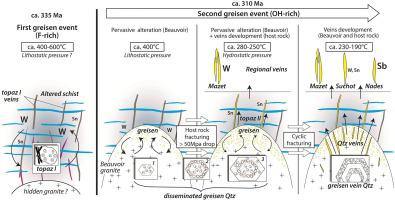当前位置:
X-MOL 学术
›
Ore Geol. Rev.
›
论文详情
Our official English website, www.x-mol.net, welcomes your feedback! (Note: you will need to create a separate account there.)
Contrasting fluid behavior during two styles of greisen alteration leading to distinct wolframite mineralizations: the Echassières district (Massif Central, France)
Ore Geology Reviews ( IF 3.3 ) Pub Date : 2020-09-01 , DOI: 10.1016/j.oregeorev.2020.103648 Loïs Monnier , Stefano Salvi , Victor Jourdan , Souleymane Sall , Laurent Bailly , Jérémie Melleton , Didier Béziat
Ore Geology Reviews ( IF 3.3 ) Pub Date : 2020-09-01 , DOI: 10.1016/j.oregeorev.2020.103648 Loïs Monnier , Stefano Salvi , Victor Jourdan , Souleymane Sall , Laurent Bailly , Jérémie Melleton , Didier Béziat

|
Abstract The Echassieres district of central France hosts diverse magmatic and magmatic- hydrothermal deposits of rare metals, mostly related to the well-known Beauvoir granite. Tungsten mineralization crops out at three distinct wolframite occurrences, the two most important of which are related to two distinct magmatic bodies, emplaced ca. 335 and 310 Ma (Monnier et al., 2019). The mineralization occurred at 335 Ma formed during a hydrothermal episode marked by precipitation of topaz replacing quartz in a stockwork system and as veinlets in the surrounding schist. Fluid inclusions in topaz and quartz display similar features, i.e., all have low salinity, contain significant amount of LiCl, display constant liquid/vapor ratios, and homogenized within a narrow temperature range (Th ≈ 380 °C). No evidence for fluid pressure variations was observed, and temperature decrease is considered to be the main cause for wolframite deposition. The younger W mineralization is related to greisenizing fluids that altered the Beauvoir granite and generated several quartz (±topaz and apatite) veins. All greisen-related fluid inclusions display low salinity, however, Th are spread from ca. 190 to 400 °C, and several populations exhibit heterogeneous liquid/vapor ratios while others consist of only vapor-rich fluid inclusions. Respectively, these populations are interpreted to have been trapped during boiling or flashing (vaporization) of the fluid. In contrast with the other regional veins, flashing was particularly intense in the Mazet veins, which host the bulk of the last wolframite generation. Consequently, it is proposed that flashing is the key factor that triggered W precipitation. This work highlights the role of two physical parameters, pressure and temperature, whose variations played a preponderant role on wolframite mineralization. It documents, in depth, an example of greisen fluid evolution, providing critical information on W behavior in orthomagmatic fluids, and on greisen-related rare-metal deposits.
中文翻译:

两种类型的 greisen 蚀变期间的对比流体行为导致不同的黑钨矿矿化:Echassières 地区(法国中部地块)
摘要 法国中部的 Echassieres 地区拥有多种稀有金属的岩浆和岩浆热液矿床,主要与著名的波伏瓦花岗岩有关。钨矿化在三个不同的黑钨矿产地出现,其中最重要的两个与两个不同的岩浆体有关,大约在 335 和 310 Ma(Monnier 等,2019)。矿化发生在 335 Ma 形成于热液事件期间,其特征是黄玉沉淀取代了网状系统中的石英,并在周围片岩中形成细脉。黄玉和石英中的流体包裹体显示出相似的特征,即都具有低盐度、含有大量 LiCl、显示恒定的液体/蒸汽比,并且在狭窄的温度范围内 (Th ≈ 380 °C) 均质化。没有观察到流体压力变化的证据,温度下降被认为是黑钨矿沉积的主要原因。较年轻的 W 矿化与改变 Beauvoir 花岗岩并产生几个石英(±黄玉和磷灰石)矿脉的灰化流体有关。所有与 greisen 相关的流体包裹体都显示出低盐度,但是,Th 分布于约 190 到 400 °C,几个种群表现出不均匀的液体/蒸汽比,而其他种群仅由富含蒸汽的流体包裹体组成。相应地,这些种群被解释为在流体沸腾或闪蒸(汽化)过程中被捕获。与其他区域矿脉相比,Mazet 矿脉中的闪蒸特别强烈,该矿脉是最后一代黑钨矿的大部分所在。因此,提出闪蒸是引发 W 降水的关键因素。这项工作突出了压力和温度这两个物理参数的作用,它们的变化对黑钨矿的成矿起主导作用。它深入记录了 grisen 流体演化的一个例子,提供了关于正岩浆流体中 W 行为的关键信息,以及与 grisen 相关的稀有金属矿床。
更新日期:2020-09-01
中文翻译:

两种类型的 greisen 蚀变期间的对比流体行为导致不同的黑钨矿矿化:Echassières 地区(法国中部地块)
摘要 法国中部的 Echassieres 地区拥有多种稀有金属的岩浆和岩浆热液矿床,主要与著名的波伏瓦花岗岩有关。钨矿化在三个不同的黑钨矿产地出现,其中最重要的两个与两个不同的岩浆体有关,大约在 335 和 310 Ma(Monnier 等,2019)。矿化发生在 335 Ma 形成于热液事件期间,其特征是黄玉沉淀取代了网状系统中的石英,并在周围片岩中形成细脉。黄玉和石英中的流体包裹体显示出相似的特征,即都具有低盐度、含有大量 LiCl、显示恒定的液体/蒸汽比,并且在狭窄的温度范围内 (Th ≈ 380 °C) 均质化。没有观察到流体压力变化的证据,温度下降被认为是黑钨矿沉积的主要原因。较年轻的 W 矿化与改变 Beauvoir 花岗岩并产生几个石英(±黄玉和磷灰石)矿脉的灰化流体有关。所有与 greisen 相关的流体包裹体都显示出低盐度,但是,Th 分布于约 190 到 400 °C,几个种群表现出不均匀的液体/蒸汽比,而其他种群仅由富含蒸汽的流体包裹体组成。相应地,这些种群被解释为在流体沸腾或闪蒸(汽化)过程中被捕获。与其他区域矿脉相比,Mazet 矿脉中的闪蒸特别强烈,该矿脉是最后一代黑钨矿的大部分所在。因此,提出闪蒸是引发 W 降水的关键因素。这项工作突出了压力和温度这两个物理参数的作用,它们的变化对黑钨矿的成矿起主导作用。它深入记录了 grisen 流体演化的一个例子,提供了关于正岩浆流体中 W 行为的关键信息,以及与 grisen 相关的稀有金属矿床。



























 京公网安备 11010802027423号
京公网安备 11010802027423号